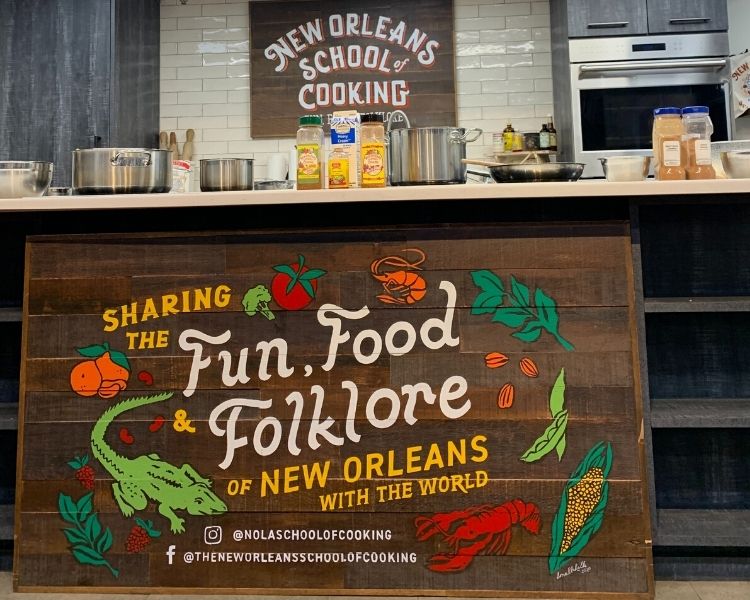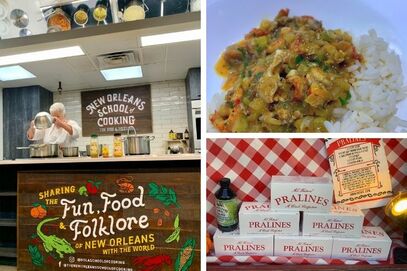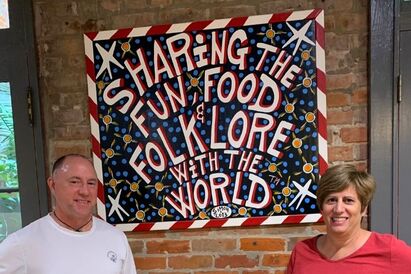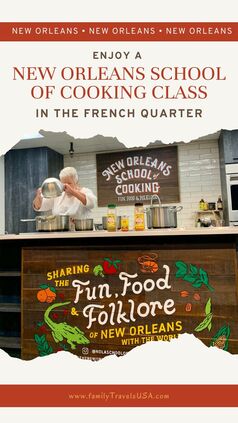|
Have you ever considered taking a cooking class while on vacation? While making a meal with the locals in a picturesque town in Italy is still on my bucket list, I hadn’t really thought about it when we were planning our November trip to New Orleans. It was hard enough trying to decide where to eat, with so many amazing restaurants to choose from. In a place where the local cuisine has made a name for itself, taking a class at the New Orleans School of Cooking was the perfect way to learn the history behind some of the city’s iconic dishes. Each class combines the hospitality and history of New Orleans cuisine in a fun and engaging way. Chef instructors guide you through the steps for classic dishes like Crawfish Étouffée, Jambalaya, and Bread Pudding, weaving in the layers of global influence to the local cuisine and culture. So as you make your list of things to do in New Orleans, don’t miss adding a cooking class at the New Orleans School of Cooking. Centrally located yet tucked away between Decatur and Chartres Streets, a small sign and colorful window scene might draw you inside the Louisiana General Store on this otherwise quiet street. We were fortunate to have heard about the cooking school from my daughter, who had recently shared how much fun she had taking an evening, hands-on cooking class. So when I started making my list of things to see and do during our trip, the New Orleans School of Cooking had to be included. Even better, it was literally right around the corner from our hotel, the historic French Market Inn on Decatur Street. Browsing through the class schedule about a week before our November visit, the popular hands-on classes were already sold out. Given the significant price difference between the hands-on and demonstration class for our group of 4, in the end the demonstration class was a better budget-friendly option. But really, either type of class would be a fun activity for both couples and a family with older teens and twenty-something age kids. On the morning of our class, we arrived around 9:45 for the 10:00 a.m. class, with ample time to browse all the regional spices and fun kitchen accessories in the shop. The class ran from 10:00 a.m. to about 12:30, and we did not leave hungry! Chef Pat ‘s storytelling kept us engaged as she shared stories behind the layers of cuisine that make New Orleans what it is today. It was fascinating to hear how cultures all over the world, including African, French, Native American, Spanish, and Italian influenced the cuisine with native spices, traditions, ways of cooking, and more. At the same time, our chef was busy preparing our lunch, walking us through the recipes step by step. First up was the bread pudding, which needed to get in the oven since it took a while to bake. Who would have thought fresh blueberries would have been so tasty in white chocolate bread pudding? We learned this recipe evolved from a simple necessity to use stale bread, to a next level gourmet dessert prepared by chefs all over New Orleans. Did I mention that they provide recipes of all the dishes, so that you can recreate the experience in your own kitchen? Probably a good thing, since Chef Pat seemed to eyeball most of the ingredients rather than measuring them! Let’s just say there appeared to be plenty of seasoning in each dish. But I’m excited to test all the recipes at home, and have already tried the Shrimp and Artichoke Soup! During the soup lesson, Chef Pat took the mystery out of making a basic roux (essential for so many recipes like gumbo and étouffée). And when she started assembling the main course—Crawfish Étouffée—we learned more about the nuances of roux based on the ratio of flour to butter. A fun fact I discovered while writing this post, is that Louisiana is one of the largest producers of crawfish in the country. Pat also shared that the base of many Cajun dishes is known as the “holy trinity”—onions, celery, and green pepper! Basically a variation of the French mirepoix, with its combination of onions, carrots, and celery. Speaking of Cajun and Creole food, the Louisiana Travel site has a fun article that does a good job explaining what distinguishes the two types of cuisines, and it’s not just that you often find tomatoes in Creole cuisine. To end the class, we learned a bit about the history of pralines, a simple sweet treat found all through the French Quarter. It’s a melt in your mouth combination of sugar, butter, milk, and pecans that is said to have originated in France in the 17th century. Like everything else, the recipe was adapted once French settlers reached Louisiana, with the almonds swapped out for plentiful pecans. Women Pralinières in the 19th century, who often had no way to earn money, sold pralines on the streets of New Orleans. Today, it's easy to find them while strolling around the French Quarter. Enjoying freshly made, warm pralines was a sweet ending to our demonstration class. You can also pick up a box of fresh pralines on your way out of the store. Here’s two other things to know before you go: ➔ Reserve in advance if you can for the best choice of classes at the New Orleans School of Cooking. It’s always important to understand the cancellation policy before you make a reservation. ➔ Plan some time to browse the shop before or after your class. Pin For Later
6 Comments
2/2/2022 04:55:18 pm
I have fun memories of visiting NOLA and I’m ready to go back. This will now be an addition to our list fun things to do during our return visit. Thanks for sharing!
Reply
KathyWaggoner
12/6/2022 06:47:14 am
I’m so glad to see the school is still operating! I was there years ago when my sister & brother-in-law lived in Harvey,LA. During one of my visits with my Mom & Dad, my sister suggested we go to the cooking school for a demonstration class. Joe Cahn was the chef & owner of The New Orleans School of Cooking! What a great time we had! He made bread pudding & whiskey sauce, Jambalaya, Gumbo, & Pralines. Joe was so much fun. He called the jambalaya Two Can, Because after you drank 2 cans of beer it would be ready to eat!! We received the recipes after & I still use them to this day!
Reply
Your comment will be posted after it is approved.
Leave a Reply. |






 RSS Feed
RSS Feed
